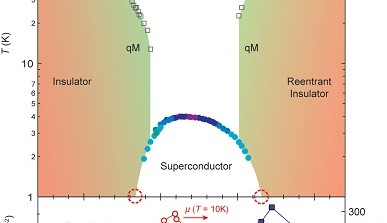The superconducting dome mystery
on

Physicists from the University of Groningen have, with colleagues from Nijmegen and Hong Kong, fabricated a superconducting, 1-molecule-thick layer of tungsten-disulphide that is activated with an electric field. By gradually increasing the field strength, they demonstrated that the material changed from an insulator to a superconductor and beyond that into an insulator again. Their measurements clearly show the 'dome shaped' superconducting phase; they were the first to come up with an explanation for this phenomenon. Their findings have been published in the Proceedings of the National Academy of Sciences.
Tungsten-disulphide
Under the leadership of University of Groningen associate professor Justin Ye they made a superconductor from tungsten disulphide (WS2) that is a single atom layer thick and normally behaves like a semiconductor and an electric field. Initially, when there a few charge carriers, WS2 is an insulator. The electric field pumps charge carriers into the insulating band, which causes conductivity to increase. At a sufficiently low temperature this can also initiate a superconducting state.
Temperature
In this phase, the temperature at which superconduction continues to exist, initially increases with an increasing electric field, but when the field increases further, this temperature drops again. These kind of dome-shaped curves have been observed with various types of superconductors in recent decades. They are particularly common in high-temperature superconductors, the operation of which still require explanation by physicists. Recently such a dome was also observed for the first time in several superconductors that were 'initiated' by an electric field. Ye and his colleagues however also observed how, with a very strong electric field, this superconducting material became an insulator again.
Phase diagram
This entire curve in the phase diagram, from insulator to superconductor and back to insulator, has never been measured so clearly before. This was achieved because a two-dimensional material was used in combination with an ionic fluid to generate an electric field that is much stronger than in earlier studies. What normally happens when charge carriers are pumped into a material that is thicker than one layer of atoms, is that the electric field at some point becomes blocked. However, the WS2 monolayer continues to pass the very strong electric field. That is how the entire curve could be determined.
Pinned in place
This allowed the researcher to see why these different phases appear. The idea is that the charge carriers in the material are ultimately pinned down by the very strong electric field. These can therefore no longer move though the material and that turnes this material into an insulator.


Discussion (0 comments)